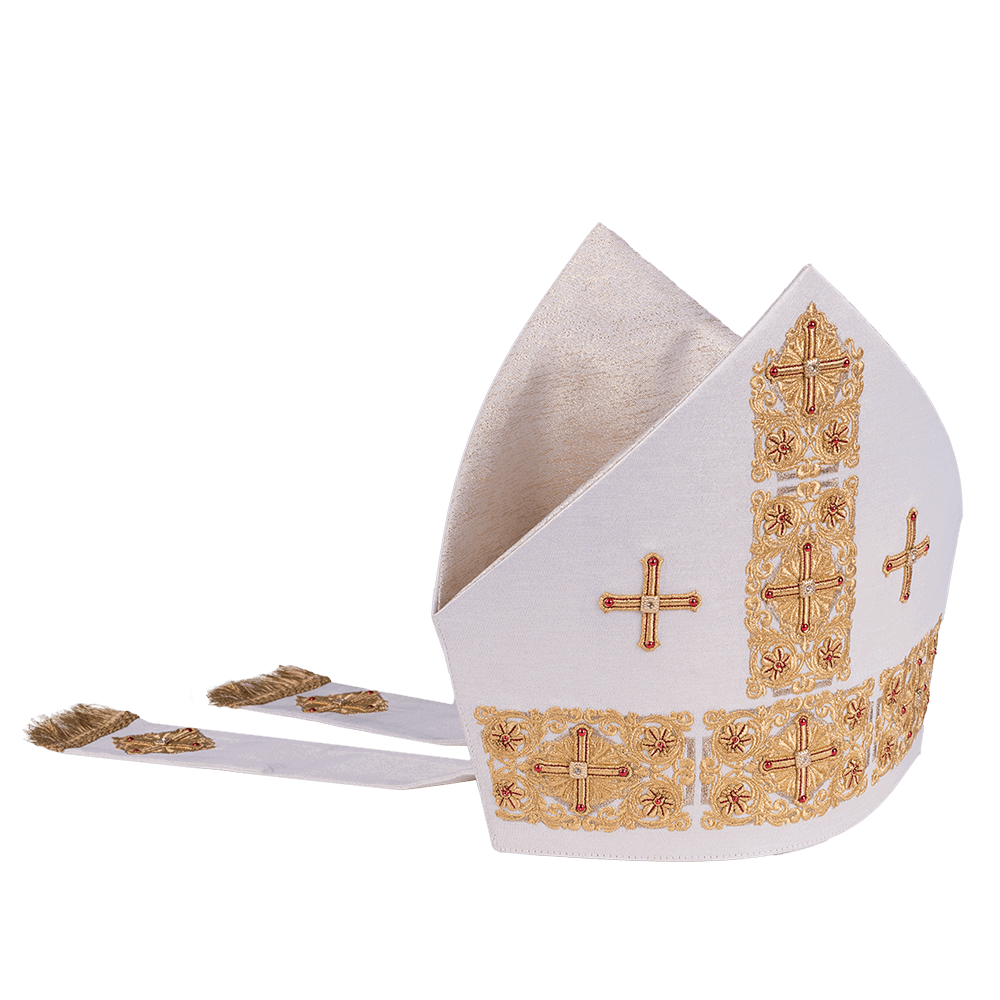Mitres
Mitres: Elevating Liturgical Vestments with Dignity and Symbolism
Understanding the Significance of Mitres in Christian Tradition
The mitre stands as one of the most recognizable and revered pieces of liturgical vestment, particularly within the Catholic, Anglican, and Orthodox Christian traditions. More than just a ceremonial hat, the mitre is a potent symbol of authority, dignity, and the sacred responsibilities entrusted to bishops and other high-ranking clergy. Delving into the history, design, and symbolism of mitres offers a deeper appreciation for their role in liturgical celebrations and ecclesiastical representation.
A Historical Journey Through the Evolution of the Mitre
The exact origins of the mitre are somewhat shrouded in mystery, but historical evidence suggests that its development can be traced back to ancient head coverings worn by secular officials and dignitaries. Over time, these head coverings were adopted and adapted by the Church, gradually evolving into the distinctive form we recognize today. Early forms of the mitre were simpler in design, often consisting of a soft, conical cap. As the Church's influence and wealth grew, mitres became increasingly elaborate, adorned with precious metals, jewels, and intricate embroidery.
The Mitre in the Early Church
During the early centuries of Christianity, head coverings were not universally worn by clergy. However, as the Church became more established, certain customs and traditions began to solidify. The use of head coverings, including early forms of the mitre, gradually became associated with bishops and other high-ranking officials, signifying their authority and status within the ecclesiastical hierarchy.
Medieval Developments and Elaborate Designs
The medieval period witnessed a significant transformation in the design and symbolism of the mitre. The simple conical cap evolved into a more structured form with two pointed peaks, known as cornua, representing the Old and New Testaments. Mitres became increasingly ornate, reflecting the wealth and power of the Church. They were often crafted from luxurious fabrics such as silk and velvet, and adorned with intricate embroidery, precious stones, and gold or silver thread. The designs often incorporated religious symbols and imagery, further enhancing the mitre's symbolic significance.
The Mitre in Modern Times
While the basic form of the mitre has remained relatively consistent in recent centuries, there have been some subtle variations in design and ornamentation. Modern mitres often reflect contemporary artistic styles and may incorporate new materials and techniques. However, the fundamental symbolism of the mitre as a sign of authority and dignity remains unchanged. In some traditions, the use of different types of mitres may be prescribed for specific liturgical occasions or ranks within the clergy.
Decoding the Symbolism Embedded in the Mitre's Design
Every aspect of the mitre's design, from its shape to its ornamentation, carries symbolic weight, reflecting the spiritual and theological significance of the office it represents. Understanding these symbols provides a deeper appreciation for the mitre's role in liturgical celebrations and ecclesiastical representation.
The Two Peaks (Cornua): Old and New Testaments
The two pointed peaks, or cornua, that characterize the mitre are traditionally interpreted as representing the Old and New Testaments. This symbolism underscores the bishop's role as a teacher and interpreter of both Scripture and Tradition. By wearing the mitre, the bishop signifies his commitment to upholding and proclaiming the entirety of God's revealed word.
The Infulae: Streams of Grace and Authority
The infulae, or lappets, are the two strips of fabric that hang down from the back of the mitre. These are often interpreted as representing the streams of grace and authority that flow from the bishop to the members of his diocese. They also symbolize the bishop's connection to the past, present, and future of the Church, linking him to the apostles and the unbroken chain of episcopal succession.
Ornate Decorations: Visual Narratives of Faith
The intricate decorations that adorn many mitres are not merely aesthetic embellishments they often serve as visual narratives of faith. Embroidered images of saints, biblical scenes, and heraldic symbols can convey important theological messages and reinforce the bishop's role as a leader and shepherd of his flock. The choice of colors and materials also carries symbolic weight, reflecting the liturgical season or the specific occasion for which the mitre is being worn.
Mitres in Different Christian Denominations: A Comparative Overview
While the mitre is primarily associated with the Catholic, Anglican, and Orthodox traditions, its use and design can vary significantly between these denominations. Examining these differences sheds light on the distinct theological and cultural contexts that shape each tradition's understanding of the mitre's significance.
Catholic Tradition: Hierarchical Distinctions in Mitre Design
In the Catholic Church, the design of the mitre often reflects the rank of the wearer. The Pope, as the supreme head of the Church, typically wears the most elaborate mitres, adorned with precious metals and jewels. Cardinals and other high-ranking officials may also wear ornate mitres, while bishops may wear simpler designs. This hierarchical distinction in mitre design underscores the importance of order and authority within the Catholic Church.
Anglican Tradition: Variations and Influences
The Anglican tradition exhibits a wider range of mitre designs, reflecting the diverse theological and liturgical practices within the Anglican Communion. Some Anglican bishops favor mitres that are similar in style to those worn in the Catholic Church, while others prefer simpler, more understated designs. The influence of both Catholic and Protestant traditions can be seen in the variety of mitres worn by Anglican bishops.
Orthodox Tradition: A Distinctive Style
The Orthodox tradition features a distinctive style of mitre that differs significantly from those worn in the Catholic and Anglican Churches. Orthodox mitres are typically bulbous in shape and adorned with intricate embroidery and icons. They often feature a cross at the top, symbolizing Christ's victory over death. The Orthodox mitre is a powerful symbol of the bishop's spiritual authority and his role as a guardian of the faith.
The Craftsmanship Behind Mitres: Materials, Techniques, and Artistry
The creation of a mitre is a meticulous process that requires a high level of skill and artistry. From selecting the finest materials to executing intricate embroidery and embellishments, every step in the process demands precision and attention to detail. Exploring the craftsmanship behind mitres reveals the dedication and expertise that goes into creating these sacred objects.
Luxurious Fabrics: Silk, Velvet, and Brocade
The choice of fabric is crucial to the overall look and feel of the mitre. Luxurious fabrics such as silk, velvet, and brocade are often favored for their rich texture and elegant drape. These materials provide a beautiful backdrop for the intricate embroidery and embellishments that adorn the mitre. The color of the fabric is also carefully selected to reflect the liturgical season or the specific occasion for which the mitre is being worn.
Embroidery Techniques: Goldwork, Silk Shading, and Appliqué
Embroidery plays a central role in the creation of many mitres. Skilled embroiderers use a variety of techniques, including goldwork, silk shading, and appliqué, to create intricate designs that depict religious symbols, biblical scenes, and heraldic emblems. The embroidery can be incredibly detailed, requiring hundreds of hours of painstaking work to complete.
Precious Embellishments: Jewels, Pearls, and Metalwork
Many mitres are further embellished with precious stones, pearls, and metalwork. These embellishments add a touch of opulence and grandeur to the mitre, reflecting the dignity and importance of the office it represents. The placement of these embellishments is carefully considered to enhance the overall design and symbolism of the mitre.
Caring for Mitres: Preservation and Maintenance
Given the value and significance of mitres, proper care and maintenance are essential to ensure their longevity. Regular cleaning, careful storage, and professional restoration can help preserve these sacred objects for generations to come. Understanding the best practices for caring for mitres is a sign of respect for the tradition and craftsmanship they represent.
Cleaning and Storage: Gentle Handling and Protective Measures
Mitres should be cleaned regularly to remove dust and dirt. Gentle handling and the use of soft brushes or cloths are recommended. Harsh chemicals or abrasive cleaners should be avoided, as they can damage the delicate fabrics and embellishments. Mitres should be stored in a cool, dry place, away from direct sunlight and moisture. Protective cases or bags can help prevent damage during storage and transportation.
Professional Restoration: Expertise and Preservation
Over time, mitres may require professional restoration to repair damage or deterioration. Skilled restorers can repair tears, replace missing embellishments, and clean and preserve the fabrics. It is important to choose a restorer who has experience working with liturgical vestments and who understands the importance of preserving the mitre's historical and artistic integrity.
The Mitre as a Symbol of Episcopal Authority and Spiritual Leadership
Ultimately, the mitre serves as a powerful symbol of episcopal authority and spiritual leadership. It represents the bishop's role as a teacher, shepherd, and guardian of the faith. By wearing the mitre, the bishop signifies his commitment to upholding the traditions of the Church and to leading his flock in the path of righteousness. The mitre is a reminder of the sacred responsibilities entrusted to those who hold positions of leadership within the Christian community.
Purchasing Mitres: A Guide to Selecting the Right Vestment
When purchasing a mitre, several factors should be considered to ensure that you select the right vestment for your needs. These factors include the style, materials, ornamentation, and fit of the mitre. Whether you are a bishop, priest, or deacon, understanding these considerations will help you choose a mitre that is both beautiful and appropriate for your role.
Style and Design: Matching Liturgical Traditions
The style and design of the mitre should be appropriate for the liturgical tradition in which it will be used. Catholic, Anglican, and Orthodox mitres each have distinct characteristics, and it is important to choose a mitre that aligns with the practices of your denomination. Consider the overall aesthetic of your church and the other vestments that will be worn during liturgical celebrations.
Materials and Ornamentation: Quality and Symbolism
The quality of the materials and the intricacy of the ornamentation are important factors to consider when purchasing a mitre. Look for mitres that are crafted from high-quality fabrics and adorned with well-executed embroidery and embellishments. The choice of materials and ornamentation should reflect the dignity and importance of the office the mitre represents.
Fit and Comfort: Ensuring Proper Wear
The fit and comfort of the mitre are also important considerations. A mitre that is too large or too small can be uncomfortable to wear and may detract from the overall appearance. Be sure to measure your head circumference accurately and choose a mitre that fits properly. Consider the weight of the mitre and choose a design that is comfortable to wear for extended periods of time.
Conclusion: The Enduring Legacy of the Mitre
The mitre stands as a timeless symbol of authority, dignity, and spiritual leadership within the Christian tradition. From its humble origins to its elaborate modern designs, the mitre has evolved over centuries, reflecting the changing cultural and theological landscapes of the Church. By understanding the history, symbolism, and craftsmanship behind the mitre, we gain a deeper appreciation for its enduring legacy and its continued relevance in contemporary liturgical practice. Whether you are a member of the clergy or a layperson, the mitre serves as a powerful reminder of the sacred responsibilities entrusted to those who lead and serve within the Christian community.







